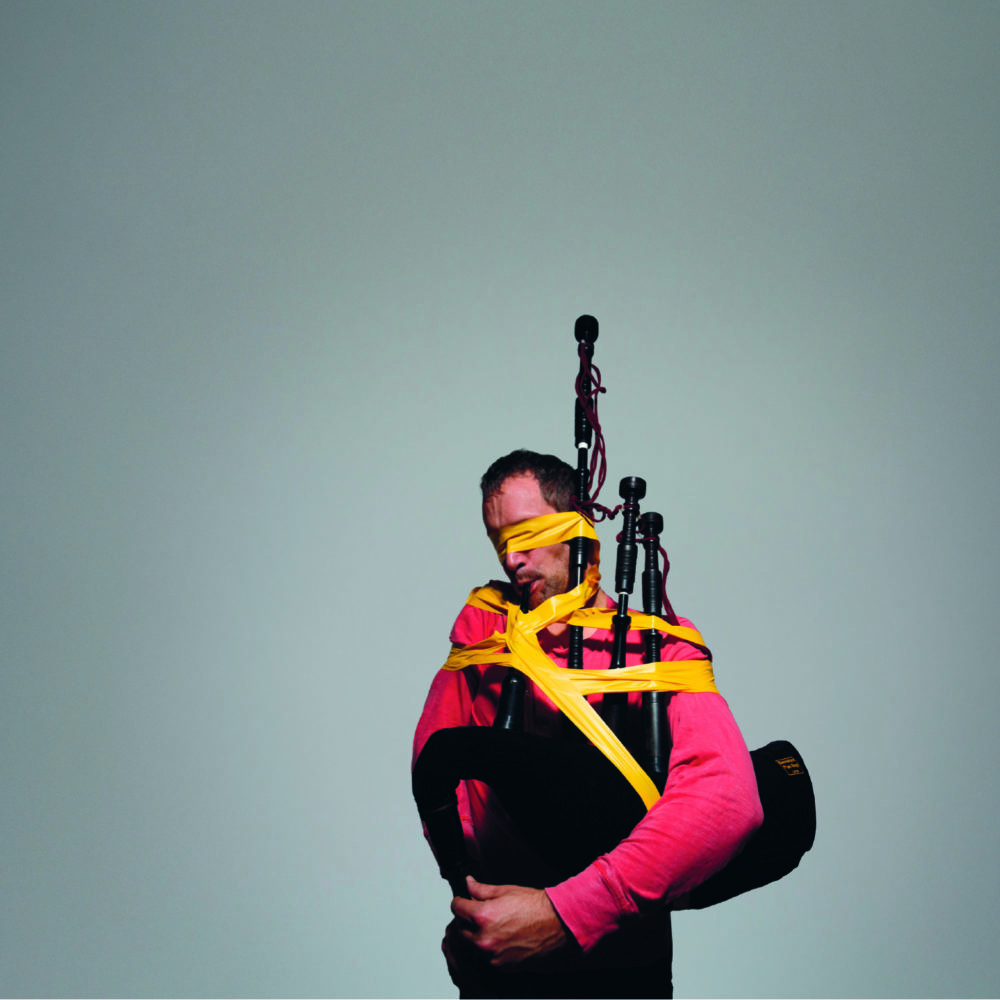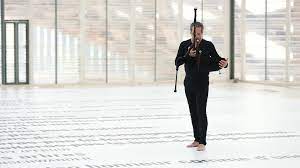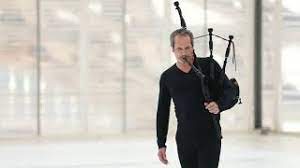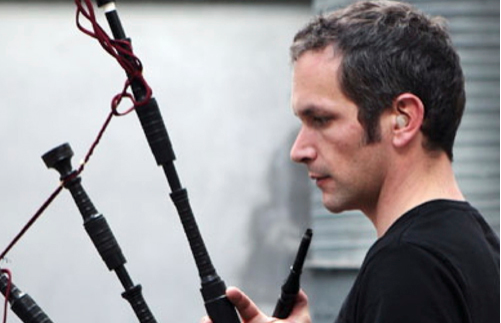Avec Erwan Keravec, nous partons pour un grand voyage, plein de promesses. En écrivant « cornemuse », « sonneur » et « Morbihan », nous savons que cette expédition nous conduit au cœur des traditions musicales bretonnes, qui font puissamment vibrer cette région. Comme toute tradition qui veut vivre, ces musiques invitent à un désir renouvelé de création, seule condition pour continuer d’exister sans se transformer en musée poussiéreux. Ces valeurs constituent justement l’ADN d’Erwan Keravec.
Entretien réalisé le 15 décembre 2020
Tu es joueur de cornemuse écossaise, on dit « sonneur ». Cet instrument a été intégré à l’instrumentarium breton il y a un siècle. Peux-tu nous en dire plus ?
La cornemuse écossaise a été jouée partout où s’était installé l’Empire britannique. Dans certains cas, les musiciens l’ont importée dans leurs traditions, comme en Bretagne, peu à peu à la fin du XIXe siècle, puis c’est devenu plus massif au milieu du XXe siècle. La cornemuse écossaise est principalement venue pour créer des pupitres dans un grand ensemble, devenu le bagad après la Seconde guerre mondiale. Elle a permis de diversifier les timbres et surtout de créer une relation différente à la bombarde, traditionnellement associée avec le biniou, qui est la cornemuse bretonne. Le biniou est accordé une octave au-dessus et n’a qu’un seul bourdon contre trois sur la cornemuse écossaise.
Pourquoi dit-on « sonneur » ?
On utilise ce mot pour tous les soufflants. La tradition sonnée bretonne est celle des binious et des bombardes, des instruments qui jouent fort. « Sonner », c’est comme envoyer loin. Ce n’est pas un mot partagé par d’autres traditions où l’on retrouve la cornemuse, comme en Centre-France, il est spécifiquement breton.
Tu l’as utilisé dans un de tes textes de présentation, presque comme un manifeste : « Erwan Keravec est un sonneur de cornemuse… Erwan sonne ses compositions… Erwan sonne en musique contemporaine… Erwan sonne pour la danse contemporaine… Erwan sonne des improvisations… Erwan sonne de la musique traditionnelle… ».
Oui, car le fait de me déplacer et de jouer dans d’autres situations que celles de la musique traditionnelle n’empêche pas que je suis un héritier, avec un enracinement. Ce qui me reste dans toutes mes expériences est que je suis un sonneur. Je fais partie de cette communauté de la tradition sonnée, j’ai suivi un enseignement au sein d’un bagad, et je me considère toujours comme un sonneur quelle que soit la musique que je joue, même expérimentale ou contemporaine.
Dans ta pratique du bagad, tu as été confronté à l’improvisation en 1995-1996 grâce à une rencontre avec la Marmite infernale, le big band de l’Arfi (Association à la recherche d’un folklore imaginaire), un collectif d’artistes lyonnais, durant laquelle tu as d’ailleurs côtoyé pour la première fois Jean-Luc Capozzo avec qui tu joues toujours. Ensuite, tu as intégré l’Arfi et tu as travaillé avec la chorégraphe Gabrielle Bourges, qui t’a ouvert le monde de la danse. Ta mutation esthétique semble en grande partie due au hasard de ces rencontres.
Ça a chamboulé mes envies, j’ai exploré des endroits que je ne connaissais vraiment pas. Ensuite, il faut y aller ! Si on ne transforme pas son jeu instrumental, il ne correspond pas à ces nouvelles pistes. Il faut pouvoir aller vers un ailleurs. J’ai eu la possibilité d’être “déplacé” grâce à des musiciens improvisateurs et à des chorégraphes. Et en 2007, je me suis lancé dans Urban Pipes, mon premier disque et programme solo. La cornemuse est très enracinée. Si l’on demande à quelqu’un l’image qui lui vient en pensant à une cornemuse écossaise, il va se représenter neuf fois sur dix un sonneur sur une colline, qui correspond à cet instrument des Highlands. Mais ne peut-on pas envisager que cet instrument puisse être vecteur d’autre chose, qu’il puisse être déplacé dans un imaginaire différent ? C’est ce qui m’a intéressé, en plaçant la cornemuse dans une situation d’improvisation, au cœur de chorégraphies et plus tard dans le cadre de commandes de musique. Il fallait que je me mette en mouvement autant que ma cornemuse. Notre capacité d’imaginer de la musique va avec notre héritage : c’est ce qu’on a reçu qu’on transforme, qu’on malaxe et qu’on parvient à envoyer ailleurs. J’ai du mal à croire que des choses puissent émerger de nulle part.
Joues-tu encore de la musique traditionnelle ?
Malheureusement de moins en moins. Quand je le fais, c’est systématiquement en musique de couple avec mon frère Guénolé, qui joue de la bombarde.
C’est en parallèle à une expérience de « musique traditionnelle imaginée » avec les quatre musiciens du groupe Niou Bardophones, dont ton frère (cornemuse, bombarde, saxophone baryton et batterie), que tu te lances dans tes projets en solo, matérialisés au départ par le disque Urban Pipes (2007).
Juste après l’enregistrement d’Air de rien en 2005 avec les Niou Bardophones, j’ai dû m’écarter de la notion de groupe pour mener à bien mon choix de m’extraire de mon endroit d’origine. Il fallait que j’aille au bout de cette idée, à laquelle je ne voulais pas renoncer, et qui ne pouvait pas être partagée. Dans un groupe, les décisions passent par une approbation collective. Par ailleurs, la cornemuse écossaise, historiquement, est un instrument solo. J’avais écrit à cette époque qu’il s’agissait d’une utopie : imaginer que mon instrument puisse être universel, le sortir de sa zone culturelle d’origine. Ce disque fut donc une pierre angulaire, me permettant de formuler mes capacités et mes incapacités. Aujourd’hui, quand je suis en discussion avec des compositeurs, c’est encore le disque de référence que je prends en exemple.
Il y a ensuite une nouvelle étape dans ton parcours, qui est celle de la création contemporaine, éloigné de tes terres d’origine : tu suscites des œuvres à des compositeurs en leur commandant des partitions. La musique des sonneurs est à l’origine basée principalement sur la tradition orale. Avec ces compositions, tu dois t’approprier la pensée de quelqu’un d’autre, habiter cette œuvre qui est sienne, qu’il a écrite et pensée pour toi. Ce faisant, tu crées un répertoire de créations originales pour ton instrument. Tu commences ces commandes à partir de 2013 et tu en es aujourd’hui à une trentaine de partitions, avec un peu plus d’une vingtaine de compositeurs, parmi lesquels, pas des moindres, des artistes internationaux reconnus de la musique contemporaine comme Eliane Radigue, Bernard Cavanna, Benjamin de la Fuente, Samuel Sighicelli, Philippe Leroux, Zad Moultaka, Heiner Goebbels, José Manuel López López, Oscar Bianchi, Dror Feiler ou Wolfgang Mitterer. Comment choisis-tu ces compositeurs à qui tu passes des commandes ?
Tu as parlé d’oralité. En fait, j’ai grandi dans une double culture. Même si je n’ai jamais été au conservatoire, toute la musique écossaise est écrite. Je lis donc la musique et je sais mettre en place, diriger, ce qui est un gros avantage de la pratique du bagad. Quand tu joues à douze cornemuses, il faut être très précis. Cela m’a permis d’être relativement à l’aise dans la pratique avec des compositeurs. Les premières œuvres ont été commandées en 2010. Sorti d’Urban Pipes, je cherchais à savoir comment et avec qui réussir à atteindre cette nouvelle musique pour mon instrument, totalement déconnectée de la tradition. Je ne suis pas venu à la musique contemporaine par l’esthétique, mais par cette quête. Cela faisait déjà huit ans que je rencontrais des musiciens de jazz, j’aurais pu aller vers eux. Mais ils m’auraient écrit des formes globales en me demandant d’improviser à l’intérieur, connaissant ma pratique. Cela ne m’intéressait pas. Je voulais qu’on m’envoie carrément ailleurs. Je voulais donc qu’on m’écrive tout, sans me laisser de choix. C’est en écoutant Deux cent quatre-vingt mesures pour clarinette (1979) de Georges Aperghis, que je me suis dit qu’il fallait que j’aille dans ce sens. Ma première rencontre a été avec le compositeur Susumu Yoshida, qui était en résidence au Théâtre de Cornouaille à Quimper. Pour la suite, j’ai surtout beaucoup écouté, et à chaque fois qu’une œuvre m’a chamboulé, je suis allé à la rencontre du compositeur. Je n’y connaissais quasiment rien, à part Steve Reich ou Philip Glass. Je n’avais même pas forcément d’accointance pour cette musique. Par ailleurs, je ne voulais pas être instruit, je voulais conserver une relation intuitive avec elle. Cela s’est manifesté par des rencontres de terrain comme avec la musique d’improvisation. Et puis je ne voulais pas non plus être uniquement un interprète de compositeurs français. Avec la musique improvisée, j’avais rencontré beaucoup de musiciens étrangers, et je m’étais rendu compte que la pratique est extrêmement vaste. Je voulais retrouver cette diversité dans la musique contemporaine, qui repose sur des manières d’échanger très diversifiées suivant les pays.
Soirée au Mucem, organisé par le Gmem à Marseille en janvier 2021 – Dror Feiler “Disobedience in B – D – eF”
Tu t’emploies depuis 2010 à créer un répertoire de partitions contemporaines écrites pour la cornemuse, dont d’autres sonneurs peuvent s’emparer. A ta connaissance, certains se sont-ils déjà appropriés ces œuvres ?
Malheureusement encore très peu. L’Accord ne m’use pas la nuit, de Bernard Cavanna, a été jouée par un autre sonneur, qui appartient à mon quatuor. Mais l’idée de répertoire ne m’est venue qu’après. Je pensais avant tout à mon propre déplacement. Cette idée ne s’impose que maintenant, face à ce massif de trente œuvres. D’un autre côté, je pense qu’il n’y a pas encore d’appropriation de la cornemuse par les compositeurs de musique contemporaine. Il me vient en tête l’exemple de Matthew Welch, pour qui ont écrit surtout des compositeurs américains, Alvin Lucier, Anthony Braxton ou Julia Wolfe. Les œuvres que je joue n’existent que parce que je les suscite. Seul Bernard Cavanna a ensuite écrit systématiquement de lui-même pour la cornemuse dans ses pièces pour orchestre.
Je voudrais aborder ton travail autour de la voix, accompagné comme tes projets le sont souvent par une sortie discographique, Vox (2015). Tu as rassemblé trois voix remarquables : Beñat Achiary, ce chanteur basque traditionnel ouvert à toutes sortes d’expériences, que tu as rencontré en 2010 et avec qui tu improvises depuis ; le baryton Vincent Bouchot et la soprano Donatienne Michel-Dansac, avec qui tu joues en trio les œuvres de quatre compositeurs. Parmi eux, José-Manuel López López, qui compose une œuvre magnifique, dramatique et inquiétante, un cri face à la mort, “No Time”. Peux-tu nous situer cette œuvre ?
José-Manuel López López est parti d’un poème très court de Dionisio Cañas, « No Time », qui évoque l’urgence et la détresse des personnes bloquées dans l’incendie du World Trade Center, se jetant dans le vide sans pouvoir dire adieu à leurs familles. J’ai suivi l’élaboration de la composition de José-Manuel pendant deux ans. Son architecture est redoutable : d’un côté, on trouve toutes les harmoniques générées par un bourdon en do, liées au poème ; et d’un autre côté, des variations rythmiques générées par les différentielles entre deux bourdons (les battements), quantifiables, que je génère tout au long de la pièce. C’est de l’horlogerie, extrêmement rigoureuse dans la construction. Mais ce que José-Manuel recherche avant tout, bien au-delà de sa structure très solide, c’est la puissance de l’expression dramatique. Je le voyais tous les deux mois et il insistait régulièrement sur cet effet qu’il souhaitait ardemment.
Dans le projet qui suit, “Sonneurs” (2017), tu te mets en quatuor avec quatre instruments de la tradition sonnée en Bretagne : le biniou, la cornemuse écossaise, la bombarde et la trélombarde.
J’ai voulu étendre ce que je faisais avec mon propre instrument aux trois autres instruments historiques de la tradition sonnée en bagad, que j’ai rassemblés dans cette formation. De manière anecdotique, il y a aussi une référence au symbole du quatuor classique.
J’ai vraiment beaucoup aimé dans ce projet l’œuvre du compositeur autrichien Wolgang Mitterer, Run. Dans cette pièce, tu te fais chef d’orchestre, tu déclenches les sons électroniques de chaque nouvelle séquence au pied. Peux-tu nous en dire un peu plus ?
J’ai rencontré la musique de Wolfgang avec son opéra Massacre, avec chant, orchestre et électronique. J’ai été bluffé par la relation qu’il parvenait à établir entre la voix et l’électronique. Il est organiste et a souvent flirté avec la musique improvisée, on se retrouve sur ces aspects. Il n’a pas peur d’utiliser l’instrument comme il est. Il a respecté les caractéristiques premières de la cornemuse, tout en l’intégrant à son univers sonore : souffle continu, bourdon en do, échelle diatonique.
Je voudrais parler avec toi d’une dernière œuvre, qui était très attendue : une commande faite à Eliane Radigue “Occam Ocean XXVII”, enregistrée sur ton disque Goebbels Glass Radigue (2020). On pouvait légitimement se demander à quoi ressemblerait l’œuvre, car on sait que, depuis une vingtaine d’années qu’elle écrit pour des instruments acoustiques, Eliane Radigue travaille sur une extrême finesse de traitement et surtout sur des sons pianissimo ou mezzo forte. Avec la cornemuse si sonore, elle a dû donc se retrouver face à un challenge considérable.
J’étais à peu près dans la même appréhension qu’Eliane. Je n’y croyais pas trop. Un ami, Cyril Jollard, directeur de la Soufflerie, ne cessait de m’en parler. J’ai fini par aller la rencontrer. On ne passe pas vraiment une commande à Eliane Radigue. Elle ne veut pas de délai, pas de date de première; elle veut pouvoir arrêter le processus à n’importe quel moment. C’est un travail très particulier. Elle décrit ce que ça doit être. Elle chemine, elle dresse une situation de jeu, et le musicien avec qui elle travaille doit l’alimenter. Si on n’y est pas, il ne se passe rien. Elle le dit elle-même : elle n’est pas là pour donner les notes qu’on doit jouer, elle ne les connaît même pas, ça ne l’intéresse pas. Le cycle Occam Ocean part toujours d’un élément faisant référence à l’eau. Je lui ai décrit un endroit, dans le Golfe du Morbihan. C’est un paysage sans falaises, sans reliefs saillants, l’environnement semble très calme, alors qu’on sait que la navigation y est paradoxalement très difficile, à cause de nombreux courants. Ça a été notre base de travail. Elle l’a interprété en mots et en descriptions. Elle n’écrit pas une note de musique mais donne des indications extrêmement précises. On ne fait absolument pas ce qu’on veut avec Eliane Radigue ! Une fondamentale est jouée tout au long de la pièce, mais elle souhaite qu’on l’oublie complètement au profit de tout ce qui est généré autour par les battements et les fluctuations du son. Nous vacillons alors, nous perdons le sens de la temporalité. Je suis presque un peu saoul quand j’ai fini la pièce. La plus grande difficulté est qu’elle ne veut aucun accident. Les bourdons ont deux tons, car on y trouve des anches ligaturées. La première émission de son va jusqu’à un certain niveau d’air, qui fait ensuite passer à une deuxième émission. Il a fallu que je cherche des solutions pour le masquer. La plus grande complexité est que sa musique demande un état particulier. Elle est sans virtuosité, mais tout en contrôle très fin. Rien ne doit s’échapper.
« L’Univers Sonore dans son intégrité, celui dans lequel chacun, celui/celle qui écoute peut entendre, trouver, retrouver, créer, sa propre musique intérieure, se laisser bercer et voyager sans fin. » Eliane Radigue
Propos recueillis par Guillaume Kosmicki



)






